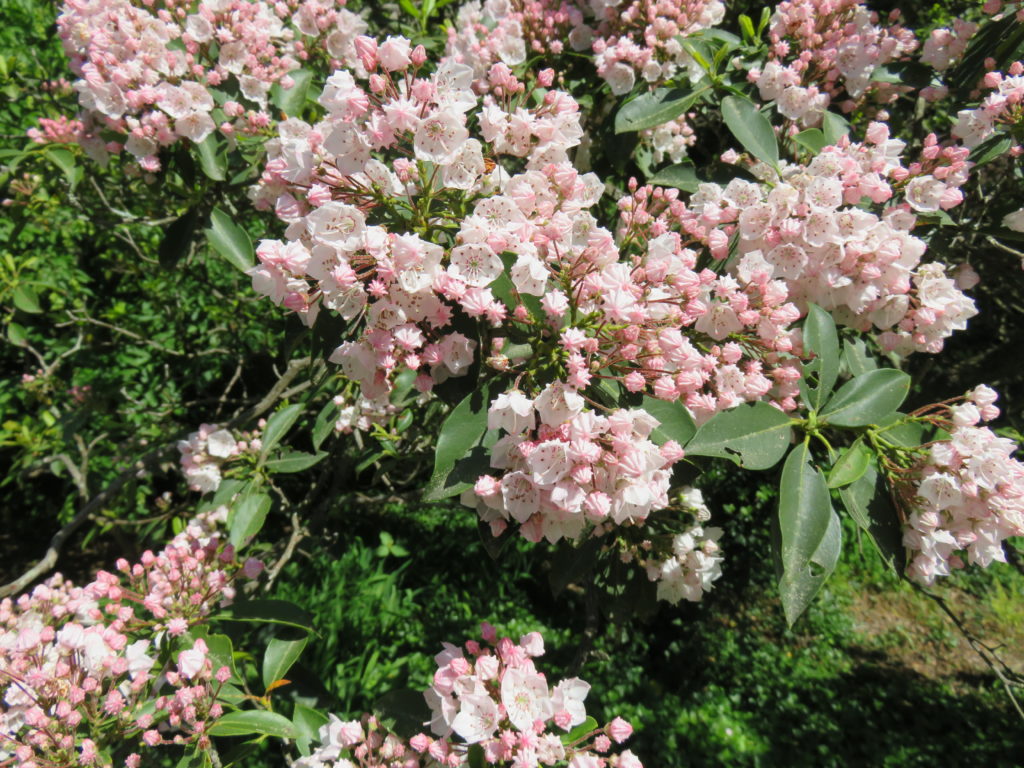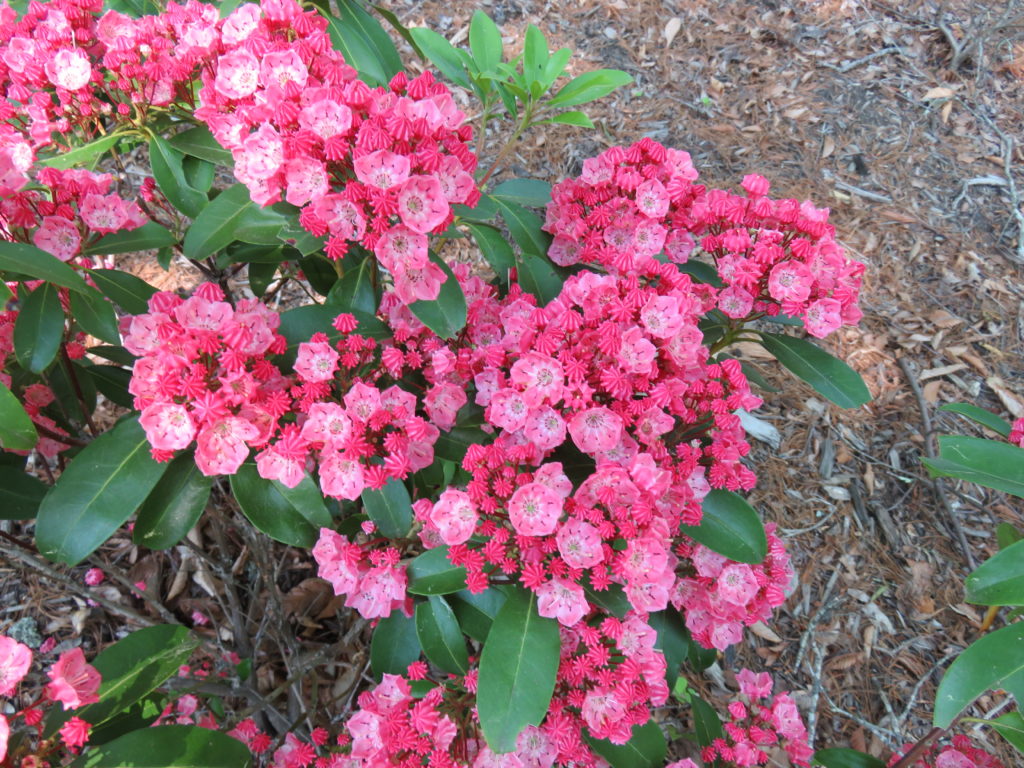Mountain laurel (Kalmia latifolia) is a U.S. native broadleaf evergreen shrub (USDA hardiness zone 5 – 7(8)). Whether you are hiking through area woodlands or driving through Biltmore Estates in Asheville, NC, flowering mountain laurels dominate the May-June landscape in Northeast Tennessee or Western North Carolina. Mature shrub sizes range from 5 feet (dwarf cultivars) to 12 feet in height and spread.

Over the past 30 years, mountain laurels have so improved, thanks to the breeding efforts of Dr. Richard Jaynes*. He has released several dozen cultivars, including dwarf forms and very colorful flowers. Some favorite varieties include ‘Carol’, ‘Sarah’, ‘Tinkerbelle’, ’Bullseye’, ‘Minuet’, and ‘Olympic Fire’.
Flowers open over a two week period beginning in mid-May here in the Southern Appalachian region (USDA hardiness zones 6 and 7). In the wild, mountain laurel tends to grow near a woodland clearing. In the garden, plant in a spot capturing partial day sunlight. Mountain laurel prospers a cool, moist, acidic (pH 6 or below preferred), compost-rich well drained soil. Established shrubs tolerate droughty soils after two years; otherwise, apply 2-3 inches of pine bark or pine needle mulch. Avoid exposure to high wintry winds.
Pruning is best performed within a few weeks after flowering is finished. Prune to shape, to limit shrub height and width, and to remove dead or diseased twigs and branches. Feeding shrubs with an acidic water soluble fertilizer such as Miracle-Gro®, Hollytone® or Schultz® spurs new growth and flowering for next spring.

Mountain laurels tend to perform more reliably than rhododendrons. They grow poorly in poorly drained soils and are susceptible to lace bug damage on the spring/summer foliage. Roots are susceptible to Phytophthora root rot. Worth repeating, mountain laurels grow best on compost–rich acidic soil
*Dr. Richard Jaynes’ book: “Kalmia: Mountain Laurel and Related Species”, 3rd ed. (Timber Press). Used copies available from Amazon Books online for under $20..
Mountain laurel (Kalmia latifolia) is a U.S. native evergreen broadleaf shrub (USDA hardiness zone 5-7 (8)). Whether you are hiking through area woodlands or driving through Biltmore Estates, flowering mountain laurels dominate the May-June natural landscape in Northeast Tennessee and Western North Carolina. Mature shrub sizes range from 5 feet (dwarf cultivars) to 12 feet in height and spread.
Over the past 30 years, mountain laurels have so improved, thanks to breeding efforts of Dr. Richard Jaynes*. He has released several dozen cultivars, including those with dwarf forms and with highly colorful flowers. Some favorite varieties include ‘Carol’, ‘Sarah’, ‘Tinkerbelle’, ’Bullseye’, ‘Minuet’, and ‘Olympic Fire’.
Flowers open over a two week period beginning in mid-May here in the Southern Appalachian region (USDA hardiness zones 6 and 7). In the wild, mountain laurel tends to grow near a woodland clearing. In the garden, plant in a spot receiving partial day sunlight. Mountain laurel prospers a cool, moist, acidic (pH 6 or below preferred), compost rich soil which is well drained. Mountain laurels tolerate droughty soils after two years in an pinebark or pine needle mulched site. Avoid exposure to high wintry winds.
Pruning is best performed within a few weeks after flowering is finished. Prune to shape, to limit shrub height and width, and to remove dead or diseased twigs and branches. Pruning and feeding with an acidic water soluble fertilizer such as Miracle-Gro®, Hollytone® or Schultz® invigorates new growth and flowering the next year.
Mountain laurels tend to perform more reliably than rhododendrons. While several plant maladies are possible, mountain laurels grow poorly in poorly drained soils and lace bug damage on the spring/summer foliage. Their roots are susceptible to Phytophthora root rot. Plants grow best on compost–rich soil
*Dr. Richard Jaynes’ book: “Kalmia: Mountain Laurel and Related Species”, 3rd ed. (Timber Press). Used copies available from Amazon Books online for under $20..

 Posted in
Posted in 
